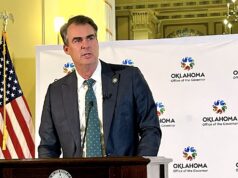Last week, eighth graders (yes, eighth graders!) led a walkout at John Marshall Mid-High protesting gun violence. According to NewsOK, about 200 students engaged in a peaceful and thoughtful expression of democratic values. They deserve praise.
Also last week, a former student carrying a loaded gun bypassed security at U.S. Grant High School. I doubt the school or the system should be criticized. The coach who reported the offender should also be praised.
Despite this recent gun scare, OKCPS security is far better than it has ever been. Let’s not forget, however, that trusting relationships, where students report threats and adults are alert to the dangers that the kids face, are the best defense against gun violence in schools.
Previous examples of faculty heroics
James Booth, the former John Marshall High School parent liaison, exemplified the very best of the OKCPS and the mentors who are so crucial to building safe learning environments. A school policeman told me that when a club-wielding student charged toward him, he had leveled his gun down and was about to pull the trigger. Then, Booth practically flew down some stairs to tackle the student, in turn saving his life.
Like the vast majority of teachers, students and patrons I know, I have long-criticized the OKCPS for failing to address chronic disorder and less serious violence (which still can lead to more than bloody noses.) In my experience, the same people who downplay routine conflicts mostly do an excellent job of protecting students from deadly violence. A great example is the assistant principal who sincerely believed that teachers should be blamed for most classroom disorder and thus refused to assess the disciplinary consequences we sought. When she faced down a student with a loaded gun, she didn’t know that it didn’t have a firing pin.
Credit where credit is due
So, the first lesson that I draw from last week’s news is that, even when we criticize the system for what we believe to be bad policy implementation, we should also give credit where credit is due.
Baby Boomers should also remember that violence has gone down dramatically since we were young and since the crack and gang violence started to recede in the early 1990s. There is a great debate over the reasons why deadly crime has declined, but I suspect that two factors are crucial. As usual, increased immigration reduces crime and violence. Also, I’ve always suspected that young people who grew up during the horrific 1980s witnessed the tragedies and decided not to repeat the behaviors that their older siblings, cousins and neighbors often exhibited.
The recent mass shootings are very worrisome, but I believe that on the whole we are now a much more peaceful society, and it is because young people willed it.
Students are on top of these issues
And that should bring us back to the discussions stimulated by John Marshall students. This winter, I helped judge Generation Citizen presentations by high school students at the State Capitol. I thought the Marshall students who studied gun violence might be too moderate for my taste, but their presentation was well-researched, balanced and mature.
The Marshall students brought in a diverse group of guest speakers, including a representative from Black Lives Matter and a sergeant from the OKCPD. After engaging in what is called “participatory action research,” they identified police relations as an issue negatively impacting their community. They called for increased police training around the use of force as well as collaborative dialogue for cultivating trust between police officers and the communities they serve.
The students also noted that 40 percent of teen gun deaths accidentally occurred inside homes and thus stressed the role of education on safety and decision-making.
I’ve also heard great things about the discussions led by Grant students on guns and other challenges to our democracy. Even before the gun incident, Grant kids were engaging in the same type of research that wowed me when speaking with Marshall students.
We owe OKCPS students a listen
That is a reminder that most OKCPS students are safer at school than in many or most of the other places where they live and work. I believe that the implicit lesson is that one of the best ways to improve our society as we reel through this bizarre time is to create schools where students are not only physically safe but also free to wrestle with social and political issues and articulate their solutions. Just as we all owe a debt of gratitude for the Parkland High School survivors in Florida for lifting the national conversation about gun violence, we owe OKCPS students a respectful listen.





















